Learning Landscapes: Playing the Way to Learning and Engagement in Public Spaces
Abstract
1. Introduction
1.1. Why Playful Learning?
1.2. Taking a New Approach
1.3. Learning Landscapes Initiative Structure
2. Learning Landscapes Projects
2.1. Ultimate Block Party: Is It Possible to Bring People together in a Public Space to Explore Playful Learning?
2.2. Supermarket Speak: How Can “Trapped Spaces” Be Infused with Learning Opportunities?
2.3. Urban Thinkscape: How Can Public Spaces Be Infused with Learning Opportunities?
2.4. Parkopolis: Can We Enrich Public Spaces Even Further by Building in More Sophisticated Content?
3. Discussion
Author Contributions
Acknowledgments
Conflicts of Interest
References
- Duncan, G.J.; Kalil, A.; Ziol-Guest, K.M. Increasing Inequality in Parent Incomes and Children’s Schooling. Demography 2017, 54, 1603–1626. [Google Scholar] [CrossRef] [PubMed]
- Hair, N.L.; Hanson, J.L.; Wolfe, B.L.; Pollak, S.D. Association of Child Poverty, Brain Development, and Academic Achievement. JAMA Pediatr. 2015, 169, 822–829. [Google Scholar] [CrossRef] [PubMed]
- Reardon, S.F. The widening income achievement gap. Educ. Leadersh. 2013, 70, 10–16. [Google Scholar]
- Hoff, E. Interpreting the Early Language Trajectories of Children from Low SES and Language Minority Homes: Implications for Closing Achievement Gaps. Dev. Psychol. 2013, 49, 4–14. [Google Scholar] [CrossRef] [PubMed]
- Verdine, B.N.; Golinkoff, R.M.; Hirsh-Pasek, K.; Newcombe, N.S.; Filipowicz, A.T.; Chang, A. Deconstructing Building Blocks: Preschoolers’ Spatial Assembly Performance Relates to Early Mathematics Skills. Child Dev. 2014, 85, 1062–1076. [Google Scholar] [CrossRef] [PubMed]
- Jordan, N.C.; Levine, S.C. Socioeconomic variation, number competence, and mathematics learning difficulties in young children. Dev. Disabil. Res. Rev. 2009, 15, 60–68. [Google Scholar] [CrossRef] [PubMed]
- Yoshikawa, H.; Weiland, C.; Brooks-Gunn, J. When Does Preschool Matter? Future Child. 2016, 26, 21–35. [Google Scholar] [CrossRef]
- Hill, C.J.; Gormley, W.T.; Adelstein, S. Do the short-term effects of a high-quality preschool program persist? Early Child. Res. Q. 2015, 32, 60–79. [Google Scholar] [CrossRef]
- Weiland, C.; Yoshikawa, H. Impacts of a prekindergarten program on children’s mathematics, language, literacy, executive function, and emotional skills. Child Dev. 2013, 84, 2112–2130. [Google Scholar] [CrossRef] [PubMed]
- Meltzoff, A.N.; Kuhl, P.K.; Movellan, J.; Sejnowski, T.J. Foundations for a New Science of Learning. Science 2009, 325, 284–288. [Google Scholar] [CrossRef] [PubMed]
- Golinkoff, R.M.; Hirsh-Pasek, K. Becoming Brilliant: What Science Tells Us about Raising Successful Children; American Psychological Association: Washington, DC, USA, 2016; ISBN 978-1-43-382239-1. [Google Scholar]
- Weisberg, D.S.; Hirsh-Pasek, K.; Golinkoff, R.M. Guided play: Where curricular goals meet a playful pedagogy. Mind Brain Educ. 2013, 7, 104–112. [Google Scholar] [CrossRef]
- UNICEF. The State of the World’s Children 2012: Children in an Urban World; UNICEF: New York, NY, USA, 2012; ISBN 978-92-806-4597-2. [Google Scholar]
- Brekke, H. How does the built environment affect behaviour and cognition? In Conscious Cities; 2016; Available online: https://www.ccities.org/how-does-the-built-environment-affect-behaviour-and-cognition/ (accessed on 22 May 2018).
- Sumerling, B. A Place to play: An exploration of people’s connection to local greenspace in East Leeds. In Conscious Cities; 2017; Available online: https://www.ccities.org/place-play-exploration-peoples-connection-local-greenspace-east-leeds/ (accessed on 22 May 2018).
- Hirsh-Pasek, K.; Zosh, J.M.; Golinkoff, R.M.; Gray, J.H.; Robb, M.B.; Kaufman, J. Putting education in “educational” apps: Lessons from the science of learning. Psychol. Sci. Public Interest 2015, 16, 3–34. [Google Scholar] [CrossRef] [PubMed]
- Weisberg, D.S.; Hirsh-Pasek, K.; Golinkoff, R.M.; Kittredge, A.K.; Klahr, D. Guided play: Principles and practices. Curr. Dir. Psychol. Sci. 2016, 25, 177–182. [Google Scholar] [CrossRef]
- Hargrave, A.C.; Sénéchal, M. A book reading intervention with preschool children who have limited vocabularies: The benefits of regular reading and dialogic reading. Early Child. Res. Q. 2000, 15, 75–90. [Google Scholar] [CrossRef]
- Zosh, J.M.; Brinster, M.; Halberda, J. Optimal Contrast: Competition Between Two Referents Improves Word Learning. Appl. Dev. Sci. 2013, 17, 20–28. [Google Scholar] [CrossRef]
- Barr, R.; Shuck, L.; Salerno, K.; Atkinson, E.; Linebarger, D.L. Music interferes with learning from television during infancy. Infant Child Dev. 2010, 19, 313–331. [Google Scholar] [CrossRef]
- Fisher, A.V.; Godwin, K.E.; Seltman, H. Visual Environment, Attention Allocation, and Learning in Young Children: When Too Much of a Good Thing May Be Bad. Psychol. Sci. 2014, 25, 1362–1370. [Google Scholar] [CrossRef] [PubMed]
- Parish-Morris, J.; Mahajan, N.; Hirsh-Pasek, K.; Golinkoff, R.M.; Collins, M.F. Once upon a time: Parent-child dialogue and storybook reading in the electronic era. Mind Brain Educ. 2013, 7, 200–211. [Google Scholar] [CrossRef]
- Tare, M.; Chiong, C.; Ganea, P.; Deloache, J. Less is more: How manipulative features affect children’s learning from picture books. J. Appl. Dev. Psychol. 2010, 31, 395–400. [Google Scholar] [CrossRef] [PubMed]
- Booth, A.E.; Waxman, S.R. Bringing theories of word learning in line with the evidence. Cognition 2003, 87, 215–218. [Google Scholar] [CrossRef]
- Chi, M.T.H. Active-constructive-interactive: A conceptual framework for differentiating learning activities. Top. Cogn. Sci. 2009, 1, 73–105. [Google Scholar] [CrossRef] [PubMed]
- Csibra, G.; Gergely, G. Natural pedagogy. Trends Cogn. Sci. 2009, 13, 148–153. [Google Scholar] [CrossRef] [PubMed]
- Kuhl, P.K.; Tsao, F.-M.; Liu, H.-M. Foreign-language experience in infancy: Effects of short-term exposure and social interaction on phonetic learning. Proc. Natl. Acad. Sci. USA 2003, 100, 9096–9101. [Google Scholar] [CrossRef] [PubMed]
- Wu, R.; Gopnik, A.; Richardson, D.C.; Kirkham, N.Z. Infants learn about objects from statistics and people. Dev. Psychol. 2011, 47, 1220–1229. [Google Scholar] [CrossRef] [PubMed]
- Fisher, K.; Hirsh-Pasek, K.; Golinkoff, R.M.; Singer, D.G.; Berk, L. Playing around in school: Implications for learning and educational policy. In The Oxford Handbook of the Development of Play; Nathan, P., Pellegrini, A.D., Eds.; Oxford Library of Psychology: Oxford, UK, 2010. [Google Scholar]
- Johnson, J.E.; Christie, J.F.; Yawkey, T.D. Play and Early Childhood Development; Longman: New York, NY, USA, 1999; ISBN 978-0-32-101166-4. [Google Scholar]
- Singer, D.G.; Singer, J.L. The House of Make-Believe: Children’s Play and the Developing Imagination; Harvard University Press: Cambridge, MA, USA, 1990; ISBN 978-0-67-440874-8. [Google Scholar]
- Henricks, T. The nature of play. Am. J. Play 2008, 1, 157–180. [Google Scholar]
- Gopnik, A. Scientific thinking in young children: Theoretical advances, empirical research, and policy implications. Science 2012, 337, 1623–1627. [Google Scholar] [CrossRef] [PubMed]
- Bonawitz, E.B.; Chang, I.Y.; Clark, C.; Lombrozo, T. Ockham’s Razor as Inductive Bias in Preschooler’s Causal Explanations. In Proceedings of the 2008 7th IEEE International Conference on Development and Learning, Monterey, CA, USA, 9–12 August 2008; pp. 7–12. [Google Scholar]
- Schulz, L.E.; Bonawitz, E.B. Serious fun: Preschoolers engage in more exploratory play when evidence is confounded. Dev. Psychol. 2007, 43, 1045–1050. [Google Scholar] [CrossRef] [PubMed]
- Bjorklund, D.F.; Gardiner, A.K. Object Play and Tool Use: Developmental and Evolutionary Perspectives. Psychol. Dev. Psychol. 2010. [Google Scholar] [CrossRef]
- Jirout, J.; Klahr, D. Children’s scientific curiosity: In search of an operational definition of an elusive concept. Dev. Rev. 2012, 32, 125–160. [Google Scholar] [CrossRef]
- Kurkul, K.E.; Corriveau, K.H. Question, Explanation, Follow-Up: A Mechanism for Learning from Others? Child Dev. 2018, 89, 280–294. [Google Scholar] [CrossRef] [PubMed]
- Legare, C.H.; Mills, C.M.; Souza, A.L.; Plummer, L.E.; Yasskin, R. The use of questions as problem-solving strategies during early childhood. J. Exp. Child Psychol. 2013, 114, 63–76. [Google Scholar] [CrossRef] [PubMed]
- Sobel, D.M.; Sommerville, J.A. The Importance of Discovery in Children’s Causal Learning from Interventions. Front. Psychol. 2010, 1, 176. [Google Scholar] [CrossRef] [PubMed]
- Toub, T.S.; Rajan, V.; Golinkoff, R.M.; Hirsh-Pasek, K. Guided play: A solution to the play versus learning dichotomy. In Evolutionary Perspectives on Child Development and Education; Geary, D., Berch, D., Eds.; Springer International Publishing: Cham, Switzerland, 2016; pp. 117–141. ISBN 978-3-31-929986-0. [Google Scholar]
- Han, M.; Moore, N.; Vukelich, C.; Buell, M. Does play make a difference? How play intervention affects the vocabulary learning of at-risk preschoolers. Am. J. Play 2010, 3, 82–105. [Google Scholar]
- Roskos, K.A.; Burnstein, K. Assessment of the design efficacy of a preschool vocabulary instruction technique. J. Res. Child. Educ. 2011, 25, 268–287. [Google Scholar] [CrossRef]
- Fisher, K.; Hirsh-Pasek, K.; Newcombe, N.; Golinkoff, R.M. Taking shape: Supporting preschoolers’ acquisition of geometric knowledge through guided play. Child Dev. 2013, 84, 1872–1878. [Google Scholar] [CrossRef] [PubMed]
- Garris, R.; Ahlers, R.; Driskell, J.E. Games, motivation, and learning: A research and practice model. Simul. Gaming 2002, 33, 441–467. [Google Scholar] [CrossRef]
- Hassinger-Das, B.; Toub, T.S.; Zosh, J.M.; Michnick, J.; Golinkoff, R.; Hirsh-Pasek, K. More than just fun: A place for games in playful learning/Más que diversión: El lugar de los juegos reglados en el aprendizaje lúdico. Infanc. Aprendiz. 2017, 40, 191–218. [Google Scholar] [CrossRef]
- Hassinger-Das, B.; Ridge, K.; Parker, A.; Golinkoff, R.M.; Hirsh-Pasek, K.; Dickinson, D.K. Building vocabulary knowledge in preschoolers through shared book reading and gameplay. Mind Brain Educ. 2016, 10, 71–80. [Google Scholar] [CrossRef]
- Ramani, G.B.; Siegler, R.S. Promoting broad and stable improvements in low-income children’s numerical knowledge through playing number board games. Child Dev. 2008, 79, 375–394. [Google Scholar] [CrossRef] [PubMed]
- Neuman, S.B.; Celano, D. Access to Print in Low-Income and Middle-Income Communities: An Ecological Study of Four Neighborhoods. Read. Res. Q. 2001, 36, 8–26. [Google Scholar] [CrossRef]
- Weisberg, D.S.; Hirsh-Pasek, K.; Golinkoff, R.M.; McCandliss, B.D. Mise en place: Setting the stage for thought and action. Trends Cogn. Sci. 2014, 18, 276–278. [Google Scholar] [CrossRef] [PubMed]
- Miller, E.; Almon, J. Crisis in the Kindergarten: Why Children Need to Play in School; Alliance for Childhood: College Park, MD, USA, 2009; ISBN 978-0-98-237510-5. [Google Scholar]
- Grob, R.; Schlesinger, M.; Pace, A.; Golinkoff, R.M.; Hirsh-Pasek, K. Playing With Ideas: Evaluating the Impact of the Ultimate Block Party, a Collective Experiential Intervention to Enrich Perceptions of Play. Child Dev. 2017, 88, 1419–1434. [Google Scholar] [CrossRef] [PubMed]
- Hirsh-Pasek, K.; Golinkoff, R.M. The great balancing act: Optimizing core curricula through playful learning. In The Pre-K Debates: Current Controversies and Issues; Zigler, E., Gilliam, W.S., Barnett, W.S., Eds.; Brookes Publishing Company: Baltimore, MD, USA, 2011; pp. 110–115. [Google Scholar]
- Betancourt, L.M.; Avants, B.; Farah, M.J.; Brodsky, N.L.; Wu, J.; Ashtari, M.; Hurt, H. Effect of socioeconomic status (SES) disparity on neural development in female African-American infants at age 1 month. Dev. Sci. 2016, 19, 947–956. [Google Scholar] [CrossRef] [PubMed]
- Johnson, S.B.; Riis, J.L.; Noble, K.G. State of the Art Review: Poverty and the Developing Brain. Pediatrics 2016, 137, e20153075. [Google Scholar] [CrossRef] [PubMed]
- Cohen, D.A.; McKenzie, T.L.; Sehgal, A.; Williamson, S.; Golinelli, D.; Lurie, N. Contribution of public parks to physical activity. Am. J. Public Health 2007, 97, 509–514. [Google Scholar] [CrossRef] [PubMed]
- Godbey, G.C.; Caldwell, L.L.; Floyd, M.; Payne, L.L. Contributions of leisure studies and recreation and park management research to the active living agenda. Am. J. Prev. Med. 2005, 28, 150–158. [Google Scholar] [CrossRef] [PubMed]
- Payne, L.L.; Orsega-Smith, E.; Roy, M.; Godbey, G.C. Local Park Use and Personal Health among Older Adults: An Exploratory Study. J. Park Recreat. Adm. 2005, 23, 1–20. [Google Scholar]
- Cohen, D.A.; Marsh, T.; Williamson, S.; Golinelli, D.; McKenzie, T.L. Impact and cost-effectiveness of family Fitness Zones: A natural experiment in urban public parks. Health Place 2012, 18, 39–45. [Google Scholar] [CrossRef] [PubMed]
- Galinsky, E.; Bezos, J.; McClelland, M.; Carlson, S.M.; Zelazo, P.D. Civic Science for Public Use: Mind in the Making and Vroom. Child Dev. 2017, 88, 1409–1418. [Google Scholar] [CrossRef] [PubMed]
- Bassok, D.; Finch, J.E.; Lee, R.; Reardon, S.F.; Waldfogel, J. Socioeconomic Gaps in Early Childhood Experiences: 1998 to 2010. AERA Open 2016, 2. [Google Scholar] [CrossRef]
- Chak, A. Teachers’ and parents’ conceptions of children’s curiosity and exploration. Int. J. Early Years Educ. 2007, 15, 141–159. [Google Scholar] [CrossRef]
- Sigel, I.E. The belief-behavior connection: A resolvable dilemma. In Parental Belief Systems: The Psychological Consequences for Children; Sigel, I.E., McGillicuddy-De Lisi, A.V., Goodnow, J.J., Eds.; Lawrence Erlbaum Associates Publishers: Mahwah, NJ, USA, 1992; pp. 433–457. [Google Scholar]
- Sigel, I.E.; McGillicuddy-De Lisi, A.V. Parent beliefs are cognition: The dynamic beliefs systems mode. In Handbook of Parenting: Being and Becoming a Parent; Bornstein, M., Ed.; Lawrence Erlbaum Associates Publishers: Mahwah, NJ, USA, 2002; Volume 3, pp. 485–508. [Google Scholar]
- Zosh, J.M.; Fisher, K.; Golinkoff, R.M.; Hirsh-Pasek, K. The Ultimate Block Party: Bridging the science of learning and the importance of play. In Design, Make, and Play; Routledge: London, UK, 2013. [Google Scholar]
- Ridge, K.E.; Weisberg, D.S.; Ilgaz, H.; Hirsh-Pasek, K.A.; Golinkoff, R.M. Supermarket Speak: Increasing Talk among Low-Socioeconomic Status Families. Mind Brain Educ. 2015, 9, 127–135. [Google Scholar] [CrossRef]
- Rosnay, M.; Hughes, C. Conversation and theory of mind: Do children talk their way to socio-cognitive understanding? Br. J. Dev. Psychol. 2006, 24, 7–37. [Google Scholar] [CrossRef]
- Brown, R. Development of the first language in the human species. Am. Psychol. 1973, 28, 97–106. [Google Scholar] [CrossRef]
- Hirsh-Pasek, K.; Adamson, L.B.; Bakeman, R.; Owen, M.T.; Golinkoff, R.M.; Pace, A.; Yust, P.K.; Suma, K. The contribution of early communication quality to low-income children’s language success. Psychol. Sci. 2015, 26, 1071–1083. [Google Scholar] [CrossRef] [PubMed]
- Cristofaro, T.N.; Tamis-LeMonda, C.S. Mother-child conversations at 36 months and at pre-kindergarten: Relations to children’s school readiness. J. Early Child. Lit. 2012, 12, 68–97. [Google Scholar] [CrossRef]
- Tamis-LeMonda, C.S.; Bornstein, M.H.; Baumwell, L. Maternal responsiveness and children’s achievement of language milestones. Child Dev. 2001, 72, 748–767. [Google Scholar] [CrossRef] [PubMed]
- Deutscher, B.; Fewell, R.R.; Gross, M. Enhancing the interactions of teenage mothers and their at-risk children: Effectiveness of a maternal-focused intervention. Top. Early Child. Spec. Educ. 2006, 26, 194–205. [Google Scholar] [CrossRef]
- Letourneau, N. Attrition among adolescents and infants involved in a parenting intervention. Child Care Health Dev. 2001, 27, 183–186. [Google Scholar] [CrossRef] [PubMed]
- Eyberg, S.M.; Nelson, M.M.; Ginn, N.C.; Bhuiyan, N.; Boggs, S.R. Dyadic Parent-Child Interaction Coding System; PCIT International: Gainesville, FL, USA, 2013. [Google Scholar]
- Morris, A.; Zapata, M.; Treat, A. Talking is Teaching in supermarkets. In Proceedings of the International Congress of Infant Studies Biennial Meeting, Philadelphia, PA, USA, 30 June–3 July 2018. [Google Scholar]
- Radesky, J.S.; Kistin, C.J.; Zuckerman, B.; Nitzberg, K.; Gross, J.; Kaplan-Sanoff, M.; Augustyn, M.; Silverstein, M. Patterns of mobile device use by parents and children during meals in fast food restaurants. Pediatrics 2014. [Google Scholar] [CrossRef] [PubMed]
- Classens, A.; Engel, M. How important is where you start? Early mathematics knowledge and later school success. Teach. Coll. Rec. 2013, 115, 1–29. [Google Scholar]
- Verdine, B.N.; Irwin, C.M.; Golinkoff, R.M.; Hirsh-Pasek, K. Contributions of executive function and spatial skills to preschool mathematics achievement. J. Exp. Child Psychol. 2014, 126, 37–51. [Google Scholar] [CrossRef] [PubMed]
- Tabors, P.O.; Snow, C.E.; Dickinson, D.K. Homes and schools together: Supporting language and literacy development. In Beginning Literacy with Language: Young Children Learning at Home and School; Paul H Brookes Publishing: Baltimore, MD, USA, 2011; pp. 1–25. [Google Scholar]
- Blair, C.; Razza, R.P. Relating effortful control, executive function, and false belief understanding to emerging math and literacy ability in kindergarten. Child Dev. 2007, 78, 647–663. [Google Scholar] [CrossRef] [PubMed]
- Hassinger-Das, B.; Toub, T.S.; Hirsh-Pasek, K.; Golinkoff, R.M. A matter of principle: Applying language science to the classroom and beyond. Transl. Issues Psychol. Sci. 2017, 3, 5. [Google Scholar] [CrossRef]
- Siegler, R.S.; Ramani, G.B. Playing linear numerical board games promotes low-income children’s numerical development. Dev. Sci. 2008, 11, 655–661. [Google Scholar] [CrossRef] [PubMed]
- Siegler, R.S.; Opfer, J.E. The development of numerical estimation: Evidence for multiple representations of numerical quantity. Psychol. Sci. 2003, 14, 237–250. [Google Scholar] [CrossRef] [PubMed]
- Dackermann, T.; Fischer, U.; Nuerk, H.C.; Cress, U.; Moeller, K. Applying embodied cognition: From useful interventions and their theoretical underpinnings to practical applications. Zdm 2017, 49, 545–557. [Google Scholar] [CrossRef]
- Fischer, U.; Moeller, K.; Class, F.; Huber, S.; Cress, U.; Nuerk, H.C. Dancing with the SNARC: Measuring spatial-numerical associations on a digital dance mat. Can. J. Exp. Psychol. 2016, 70, 306. [Google Scholar] [CrossRef] [PubMed]
- Link, T.; Moeller, K.; Huber, S.; Fischer, U.; Nuerk, H.C. Walk the number line—An embodied training of numerical concepts. Trends Neurosci. Educ. 2013, 2, 74–84. [Google Scholar] [CrossRef]
- Jordan, N.C.; Resnick, I.; Rodrigues, J.; Hansen, N.; Dyson, N. Delaware longitudinal study of fraction learning: Implications for helping children with mathematics difficulties. J. Learn. Disabil. 2017, 50, 621–630. [Google Scholar] [CrossRef] [PubMed]
- Rittle-Johnson, B.; Fyfe, E.R.; Loehr, A.M.; Miller, M.R. Beyond numeracy in preschool: Adding patterns to the equation. Early Child. Res. Q. 2015, 31, 101–112. [Google Scholar] [CrossRef]
- Geist, K.; Geist, E.A.; Kuznik, K. The patterns of music: Young children learning mathematics through beat, rhythm, and melody. YC Young Child. 2012, 67, 74. [Google Scholar]
- Sarama, J.; Clements, D.H. Building blocks for young children’s mathematical development. J. Educ. Comput. Res. 2002, 27, 93–110. [Google Scholar] [CrossRef]
- Clements, D.H. Geometric and spatial thinking in early childhood education. In Engaging Young Children in Mathematics: Standards for Early Childhood Mathematics Education; Routledge: Abingdon, UK, 2004; pp. 267–297. [Google Scholar]
- Geary, D.C.; Bailey, D.H.; Hoard, M.K. Predicting mathematical achievement and mathematical learning disability with a simple screening tool: The number sets test. J. Psychoeduc. Assess. 2009, 27, 265–279. [Google Scholar] [CrossRef] [PubMed]
- Clements, D.H.; Wilson, D.C.; Sarama, J. Young children’s composition of geometric figures: A learning trajectory. Math. Think. Learn. 2004, 6, 163–184. [Google Scholar] [CrossRef]
- Szilágyi, J.; Clements, D.H.; Sarama, J. Young children’s understandings of length measurement: Evaluating a learning trajectory. J. Res. Math. Educ. 2013, 44, 581–620. [Google Scholar] [CrossRef]
- Fuchs, L.S.; Schumacher, R.F.; Long, J.; Namkung, J.; Malone, A.S.; Wang, A.; Hamlett, C.L.; Jordan, N.C.; Siegler, R.S.; Changas, P. Effects of intervention to improve at-risk fourth graders’ understanding, calculations, and word problems with fractions. Elem. Sch. J. 2016, 116, 625–651. [Google Scholar] [CrossRef]
- Diamond, A.; Lee, K. Interventions shown to aid executive function development in children 4 to 12 years old. Science 2011, 333, 959–964. [Google Scholar] [CrossRef] [PubMed]
- Fantuzzo, J.W.; Gadsden, V.L.; McDermott, P.A. An integrated curriculum to improve mathematics, language, and literacy for Head Start children. Am. Educ. Res. J. 2011, 48, 763–793. [Google Scholar] [CrossRef]
- Green, C.T.; Bunge, S.A.; Chiongbian, V.B.; Barrow, M.; Ferrer, E. Fluid reasoning predicts future mathematical performance among children and adolescents. J. Exp. Child Psychol. 2017, 157, 125–143. [Google Scholar] [CrossRef] [PubMed]
- Verburgh, L.; Königs, M.; Scherder, E.J.; Oosterlaan, J. Physical exercise and executive functions in preadolescent children, adolescents and young adults: a meta-analysis. Br. J. Sports Med. 2013. [Google Scholar] [CrossRef] [PubMed]
- Jones, R.A.; Hinkley, T.; Okely, A.D.; Salmon, J. Tracking physical activity and sedentary behavior in childhood: a systematic review. Am. J. Prev. Med. 2013, 44, 651–658. [Google Scholar] [CrossRef] [PubMed]
- Rose, G. Strategy of prevention: Lessons from cardiovascular disease. Br. Med. J. 1981, 282, 1847–1851. [Google Scholar] [CrossRef]
- Frieden, T.R. A framework for public health action: The health impact pyramid. Am. J. Public Health 2010, 100, 590–595. [Google Scholar] [CrossRef] [PubMed]
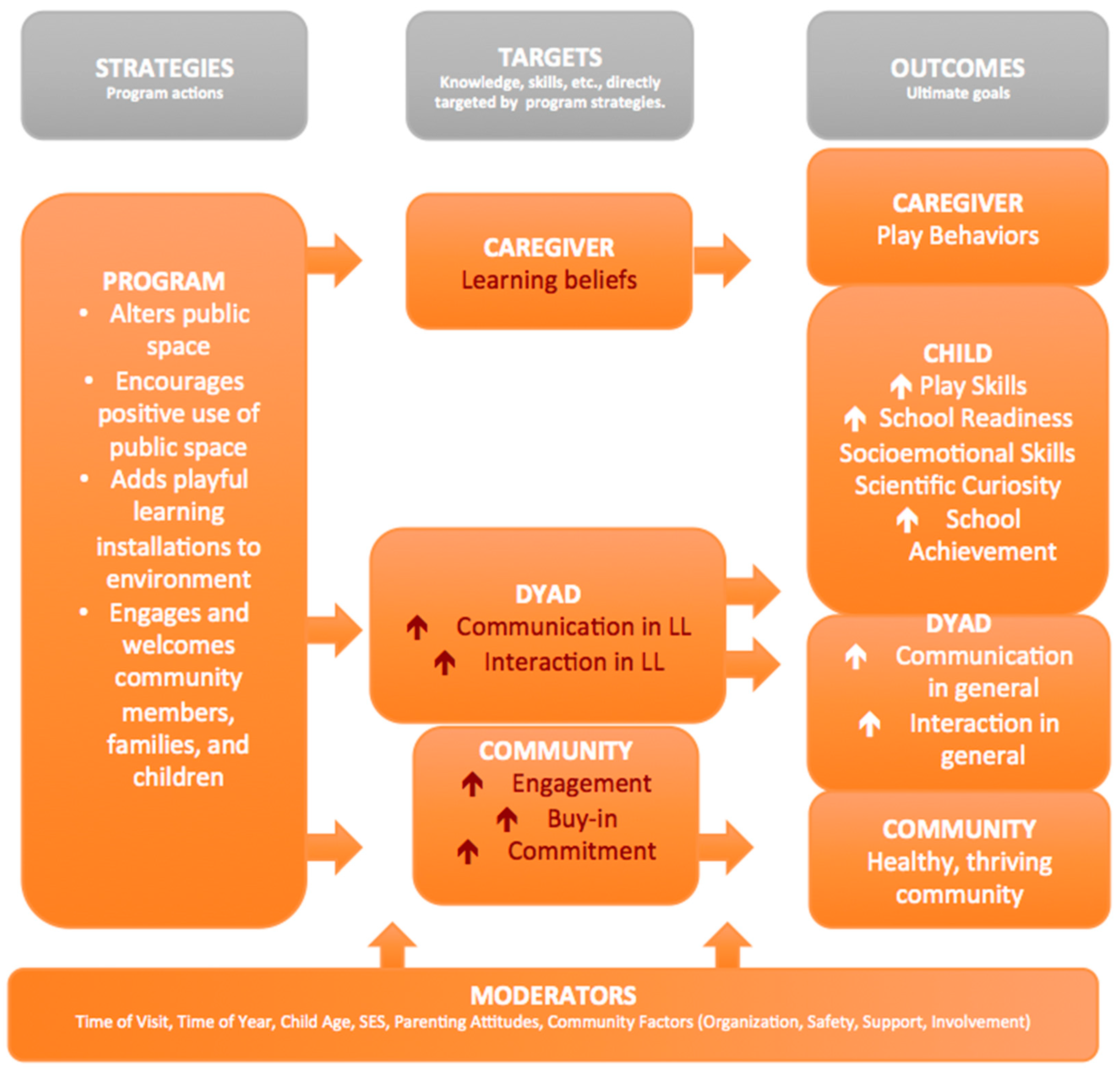
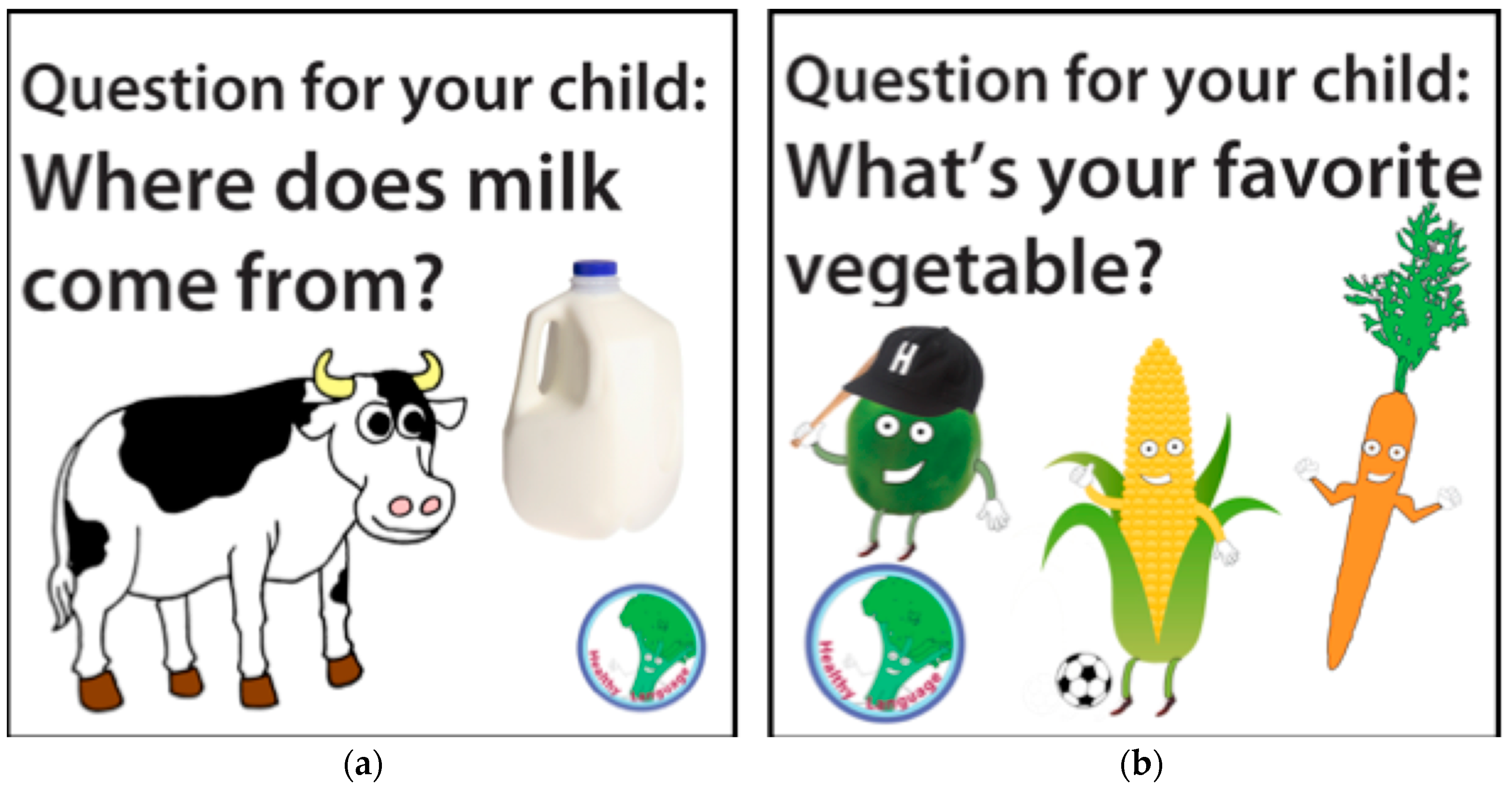
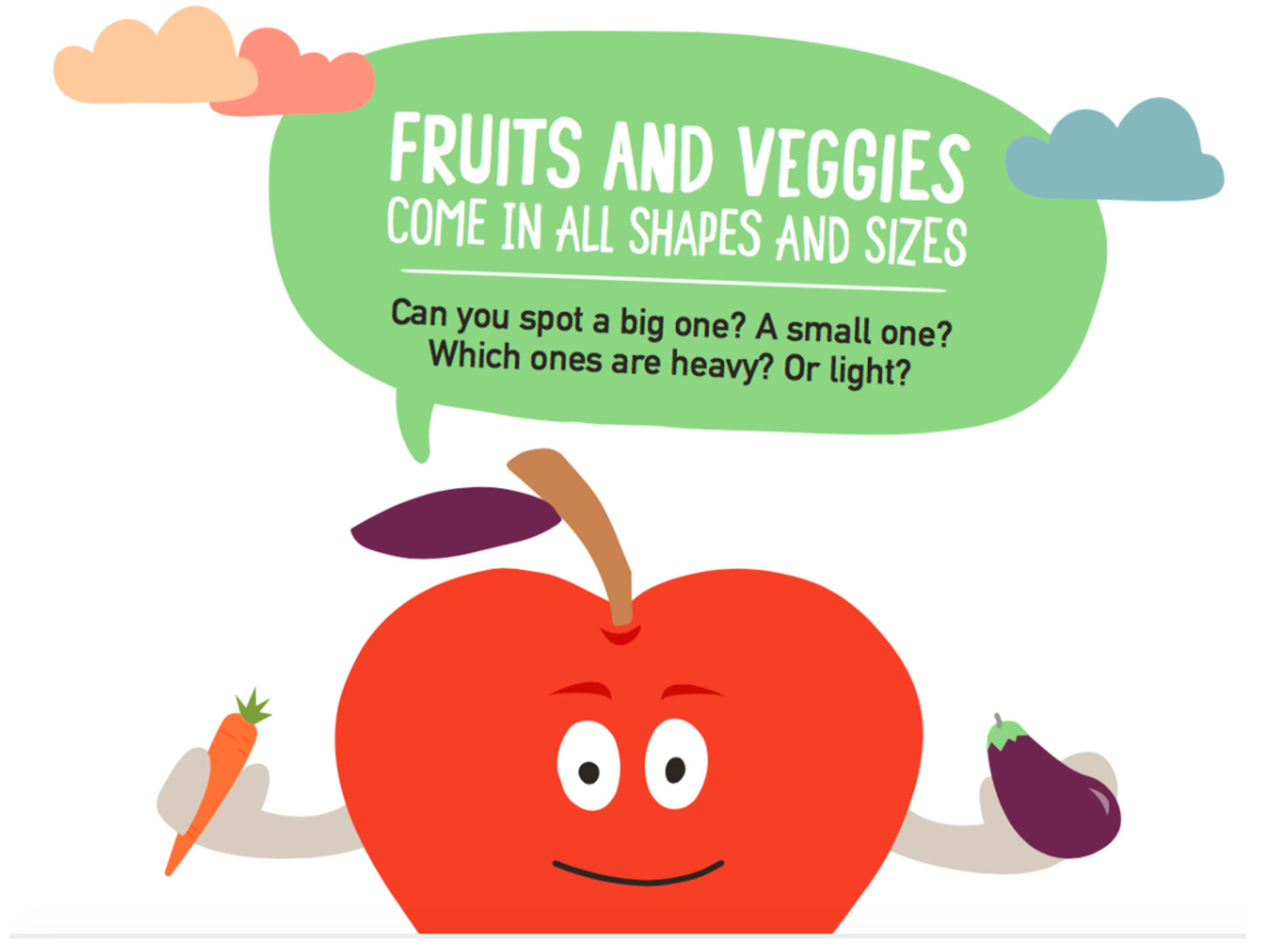
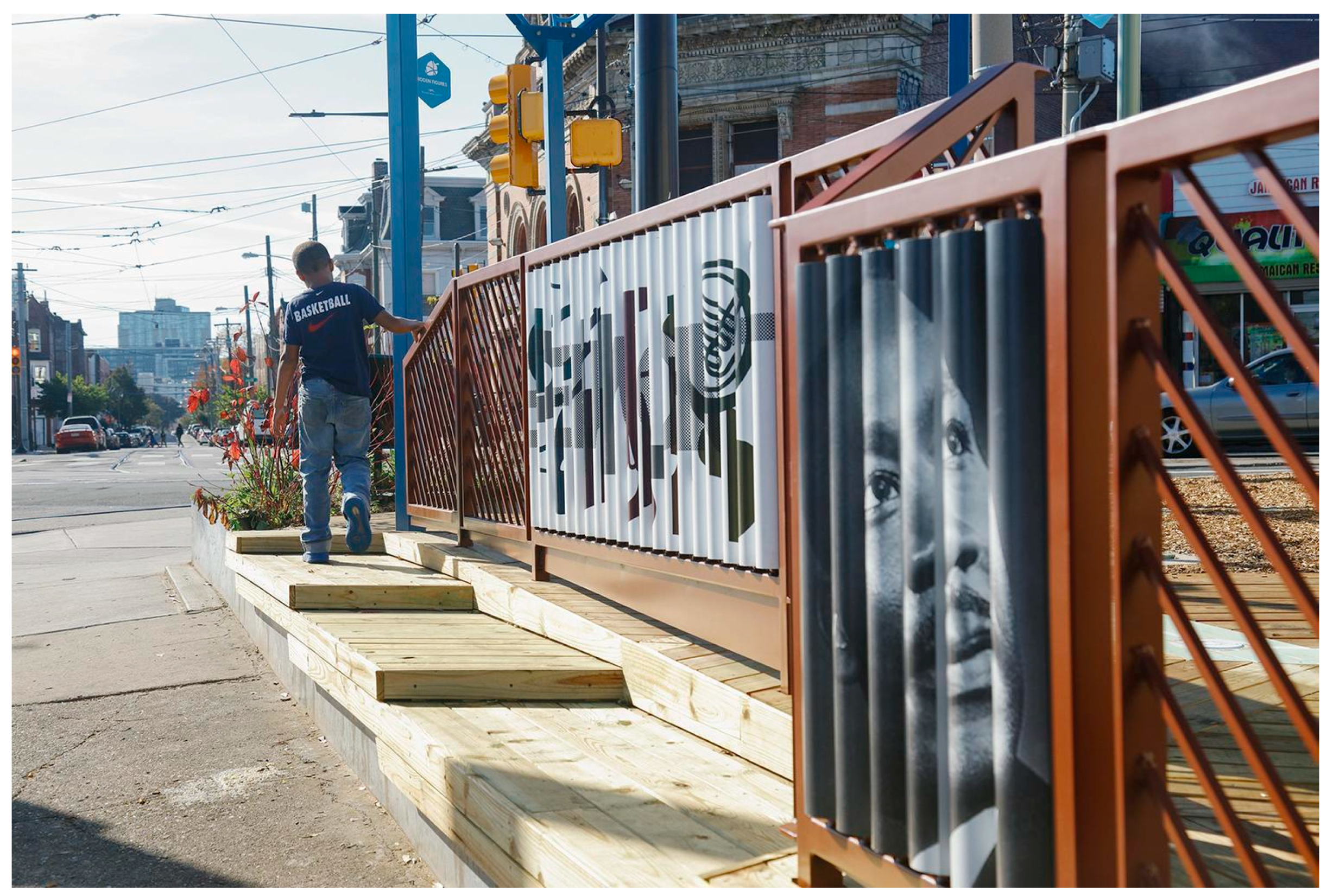
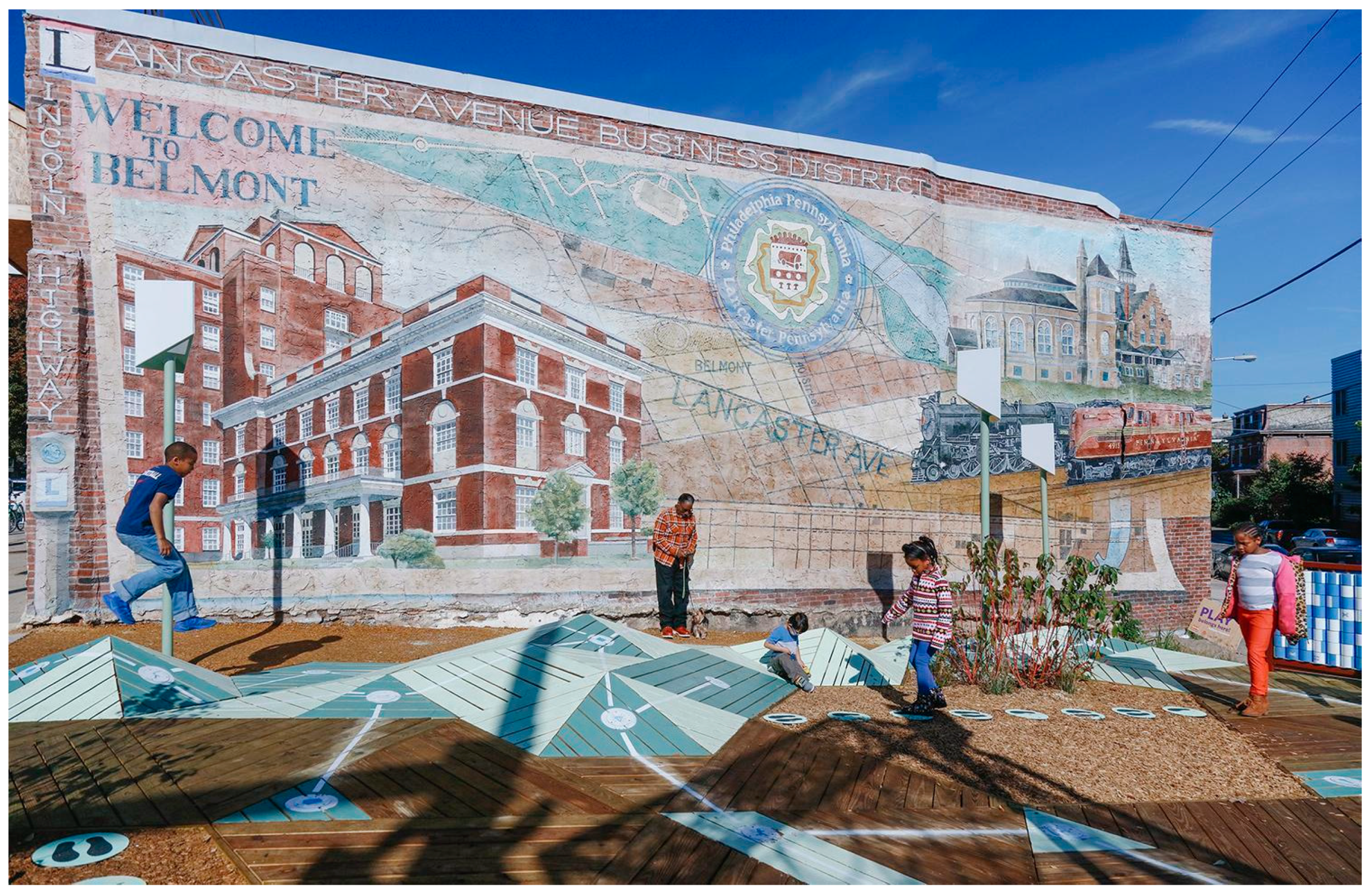
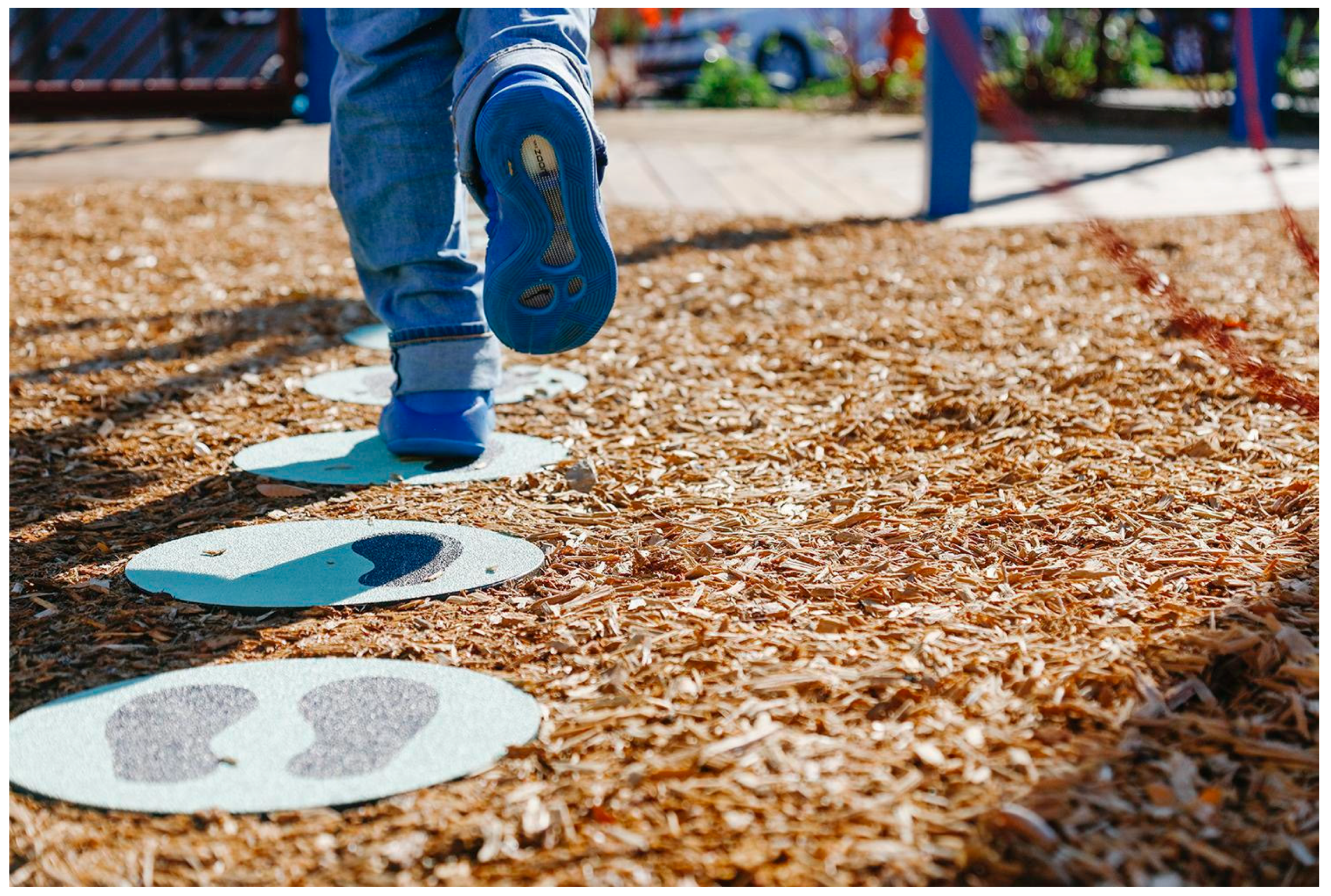
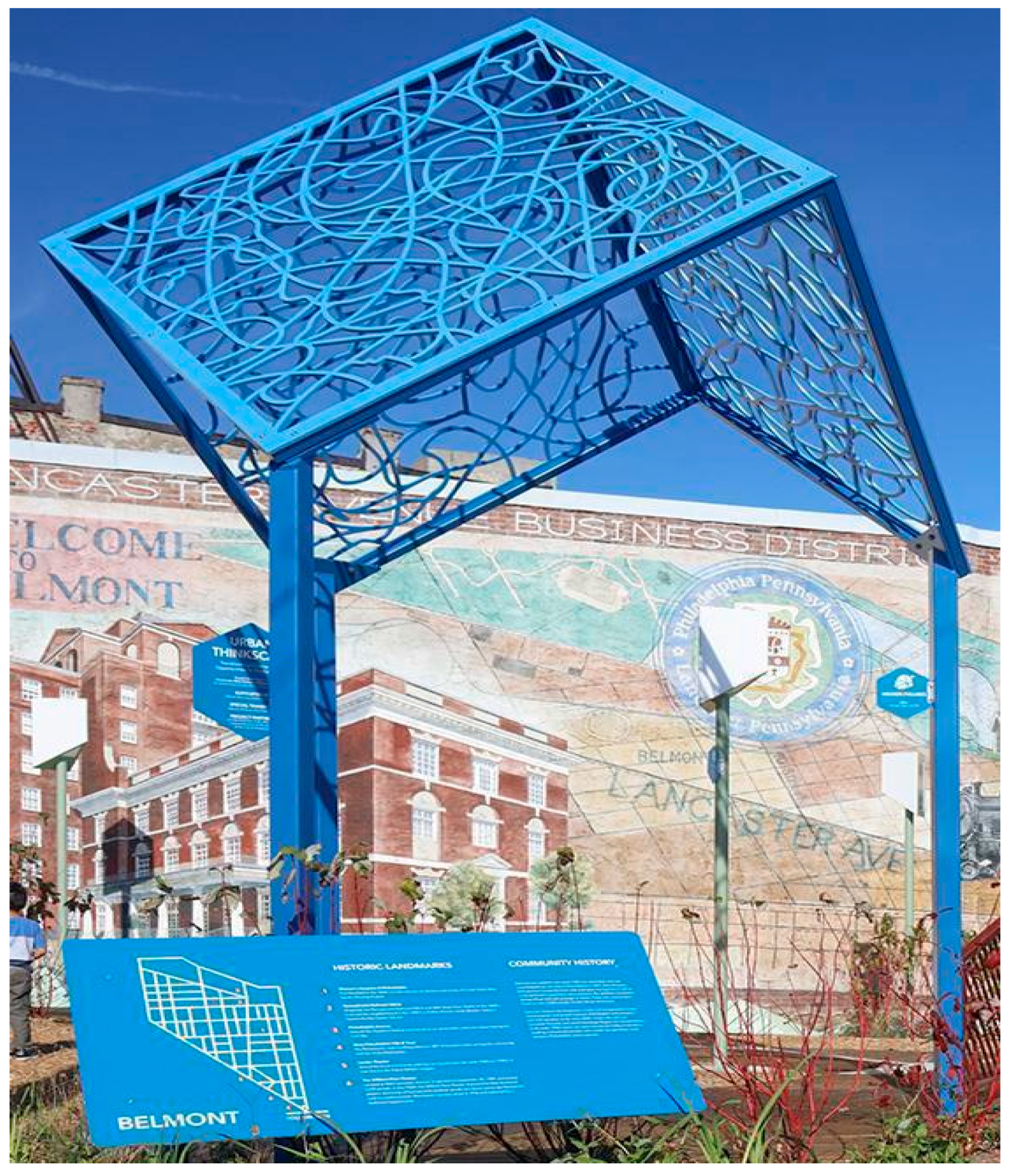

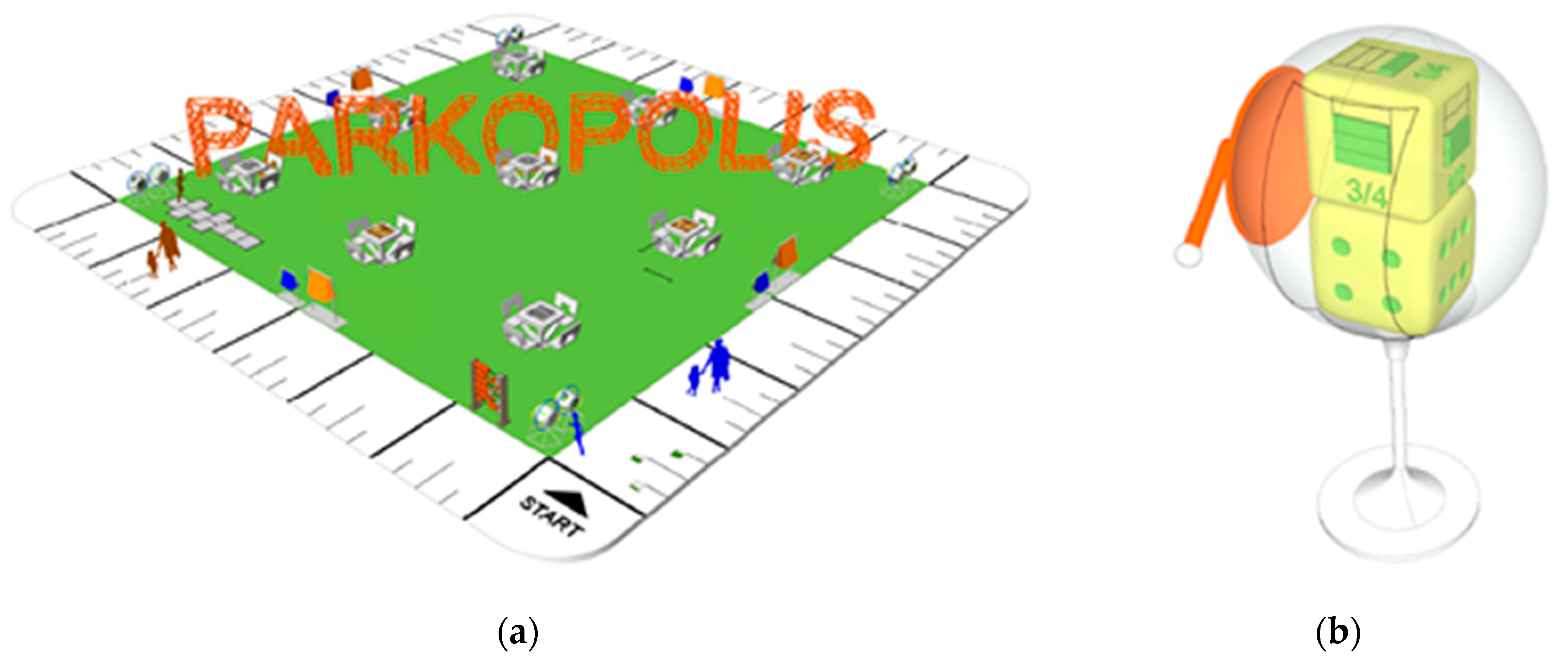
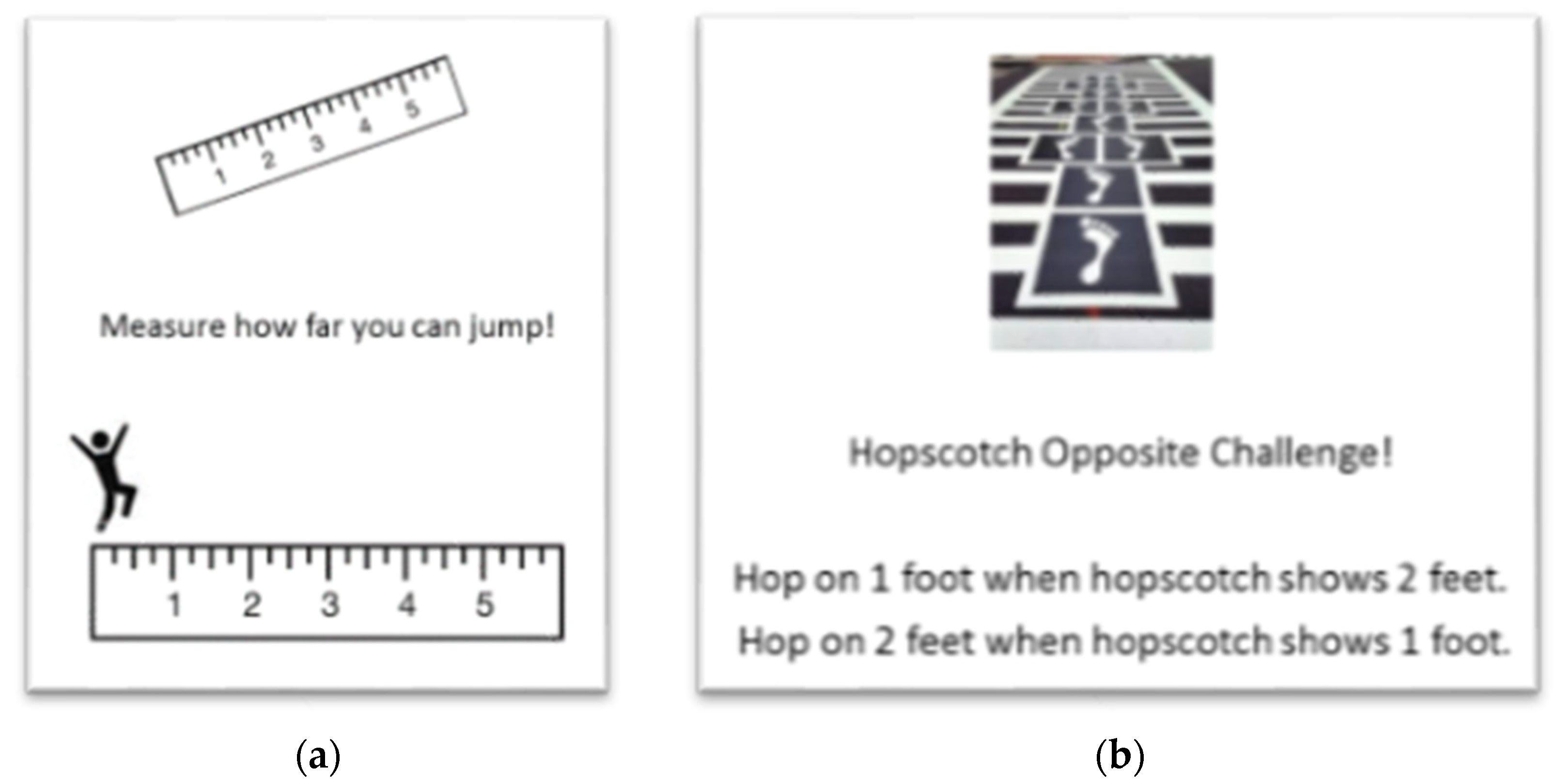
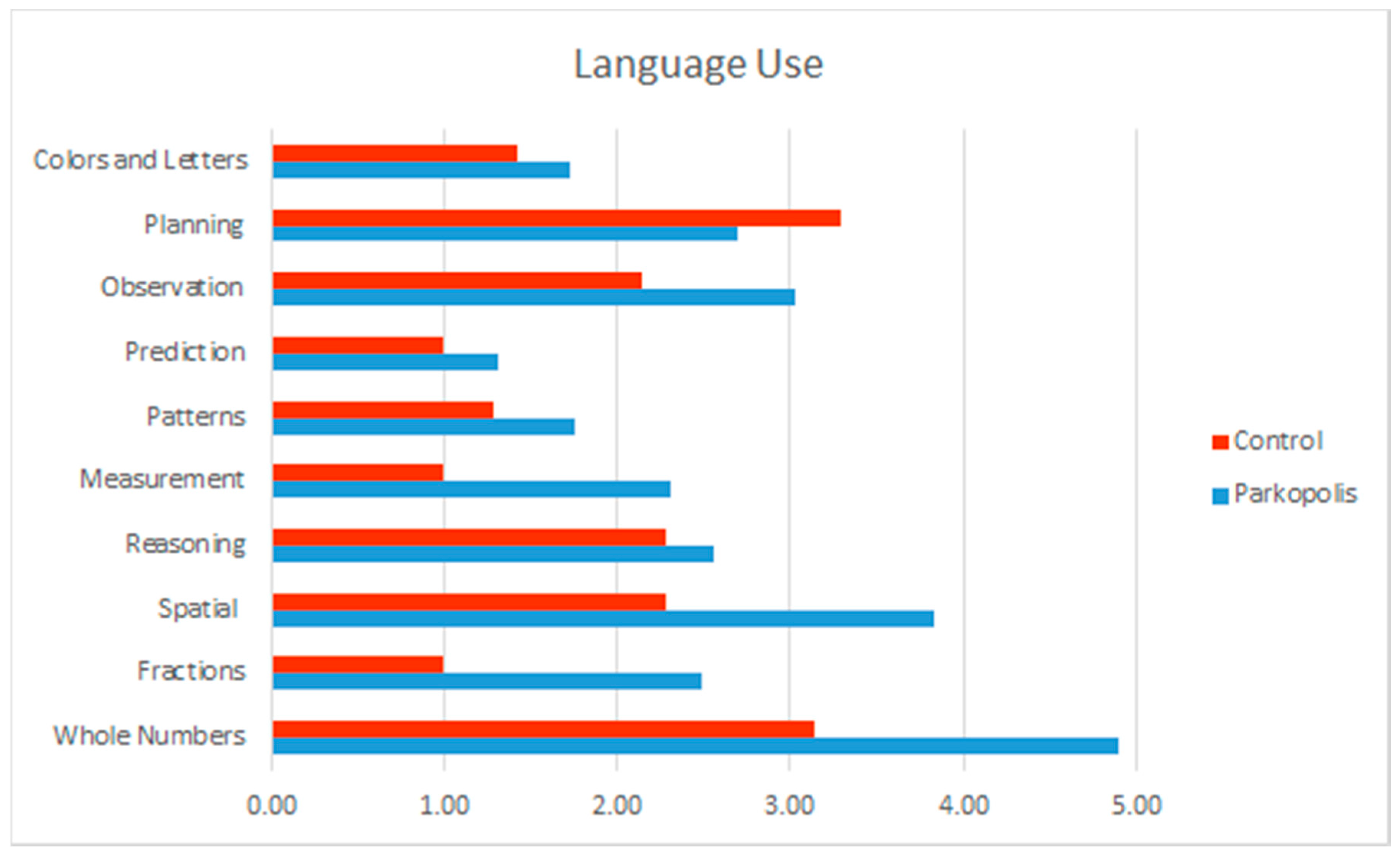
© 2018 by the authors. Licensee MDPI, Basel, Switzerland. This article is an open access article distributed under the terms and conditions of the Creative Commons Attribution (CC BY) license (http://creativecommons.org/licenses/by/4.0/).
Share and Cite
Hassinger-Das, B.; Bustamante, A.S.; Hirsh-Pasek, K.; Golinkoff, R.M. Learning Landscapes: Playing the Way to Learning and Engagement in Public Spaces. Educ. Sci. 2018, 8, 74. https://doi.org/10.3390/educsci8020074
Hassinger-Das B, Bustamante AS, Hirsh-Pasek K, Golinkoff RM. Learning Landscapes: Playing the Way to Learning and Engagement in Public Spaces. Education Sciences. 2018; 8(2):74. https://doi.org/10.3390/educsci8020074
Chicago/Turabian StyleHassinger-Das, Brenna, Andres S. Bustamante, Kathy Hirsh-Pasek, and Roberta Michnick Golinkoff. 2018. "Learning Landscapes: Playing the Way to Learning and Engagement in Public Spaces" Education Sciences 8, no. 2: 74. https://doi.org/10.3390/educsci8020074
APA StyleHassinger-Das, B., Bustamante, A. S., Hirsh-Pasek, K., & Golinkoff, R. M. (2018). Learning Landscapes: Playing the Way to Learning and Engagement in Public Spaces. Education Sciences, 8(2), 74. https://doi.org/10.3390/educsci8020074




